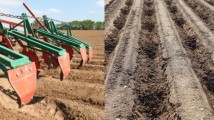Abstract
In agricultural areas, pesticide concentrations in rivers can show a highly dynamic course frequently exceeding the standards. In order to diminish these high concentration peaks and to reduce their negative impacts on the receiving ecosystem, different measures can be taken. The objective of this study is to evaluate the impact of implementation of best management practices on pesticide fluxes entering surface waters using a modelling approach. We focus on the Nil catchment, a small basin situated in the centre of Belgium. From previous studies, the SWAT model (Soil and Water Assessment Tool) was calibrated and validated for hydrology and pesticide input for this basin. Different management scenarios were simulated and compared to the initial situation. The results revealed that strip cropping seems to be more efficient than the implementation of cover crops, than buffer strips, than a 25% reduction of point losses and plough management respectively. The study showed that a modelling approach can be used to estimate the impacts of water quality management programs in river basins. Such an approach allows to rank different mitigation measures for pesticide fluxes towards surface waters.
Similar content being viewed by others
References
Arnold JG, Srinivasan R, Muttiah RS, Williams JR (1998) Large area hydrologic modelling and assessment part I: Model development. J Am Water Resour Assoc 34(1):73–89
Bärlund I, Kirkkala T, Malve O, Kämäri J (2007) Assessing SWAT model performance in the evaluation of management actions for the implementation of the Water Framework Directive in a Finnish catchment. Environ Modell Softw 22(5):719–724
Barth F, Fawell J (2001) The water framework directive and european water policy. Ecotox Environ Saf 50:103–105
Behera S, Panda RK (2006) Evaluation of management alternatives for an agricultural watershed in a sub-humid subtropical region using a physical process based model. Agric Ecosyst Environ 113:62–72
Beernaerts S, Debongnie P, Gérard M, Barthelemy J-P, Copin A, Guns M, Pussemier L (2005) Evaluation of crop-protection-product losses into surface waters with the SEPTWA system. Int J Environ Anal Chem 85:41–50
Bracmort KS, Arabi M, Frankenberger JR, Engel BA, Arnold JG (2006) Modeling long-term water quality impact of structural BMPs. Trans ASAE 49(2):367–374
Capkin E, Altinok I, Karahan S (2006) Water quality and fish size affect toxicity of endosulfan, an organochlorine pesticide, to rainbow trout. Chemosphere 64(10):1793–1800
Claver A, Ormad P, Rodríguez L, Ovelierro JL (2006) Study of the presence of pesticides in surface waters in the Ebro river basin (Spain). Chemosphere 64(9):1437–1443
Deletic A (2001) Modelling of water and sediment transport over grassed areas. J Hydrol 248(3–4):168–182
Gharabaghi B, Rudra RP, Whiteley HR, Dickinson WT (2000) Sediment-removal efficiency of vegetative filter strips. Annual research Report, ASAE Sacramento Convention Centre, Sacramento, California, USA. 32–40
Holvoet K, van Griensven A, Seuntjens P, Vanrolleghem PA (2005) Sensitivity analysis for hydrology and pesticide supply towards the river in SWAT. Phys Chem Earth 30:518–526
Holvoet K, Seuntjens P, Mannaerts R, De Schepper V, Vanrolleghem PA (2007) The water-sediment as a highly dynamic system: results of an intensive pesticide monitoring campaign. Water Sci Technol 55(3):177–182
Holvoet K, van Griensven A, Gevaert V, Seuntjens P, Vanrolleghem PA (2008) Modifications to the SWAT code for modelling direct pesticide losses. Environ Model Softw 23:72–81
Konstantinou IK, Hela DG, Albanis TA (2005) The status of pesticide pollution in surface waters of Greece. Part I. Review on occurrence and levels. Environ Pollut 141(3):555–570
Leonard RA, Knisel WG, Still DA (1987) GLEAMS: Groundwater Loading Effects of Agricultural Management Systems. Trans ASAE 30:1403–1418
Leu C, Singer H, Stamm C, Müller SR, Schwarzenbach RP (2004) Simultaneous assessment of sources, processes, and factors influencing herbicide losses to surface waters in a small agricultural catchment. Environ Sci Technol 38:3827–3834
Neitsch SL, Arnold JG, Kiniry JR, Williams JR, King KW (2002a) Soil and water assessment tool, theoretical documentation, version 2000. p 483
Neitsch SL, Arnold JG, Kiniry JR, Williams JR, King KW (2002b) Soil and water assessment tool, user’s manual, version 2000. p 412
Neitsch SL, Arnold JG, Srinivasan R (2002c) Pesticides fate and transport predicted by SWAT: atrazine, metolachlor and trifluralin in the Sugar Creek watershed. BRC Publication # 2002–03, p 96
Neumann M, Schulz R, Schäfer K, Müller W, Mannheller W, Liess M (2002) The significance of entry routes as point and non-point sources of pesticides in small streams. Water Res 36:835–842
Santhi C, Srinivasan R, Arnold JG, Williams JR (2006) A modelling approach to evaluate the impacts of water quality management plans implemented in a watershed in Texas. Environ Model Softw 21:1141–1157
Tollner EW, Vachirakornwatana C, Haan CT (1977) Sediment deposition patterns in simulated grass filters. Trans ASAE 20:940–944
Van den Brink PJ, Hattink J, Bransen F, Van Donk E, Brock TCM (2000) Impact of the fungicide carbendazim in freshwater microcosms. II. Zooplankton, primary producers and final conclusions. Aquat Toxicol 48(2–3):251–264
Wendt-Rasch L, Van den Brink PJ, Crum SJH, Woin P (2004) The effects of a pesticide mixture on aquatic ecosystems differing in trophic status: responses of the macrophyte Myriophyllum spicatum and the periphytic algal community. Ecotox Environ Safe 57(3):383–398
Author information
Authors and Affiliations
Corresponding author
Rights and permissions
About this article
Cite this article
Holvoet, K., Gevaert, V., van Griensven, A. et al. Modelling the Effectiveness of Agricultural Measures to Reduce the Amount of Pesticides Entering Surface Waters. Water Resour Manage 21, 2027–2035 (2007). https://doi.org/10.1007/s11269-007-9199-3
Received:
Accepted:
Published:
Issue Date:
DOI: https://doi.org/10.1007/s11269-007-9199-3




